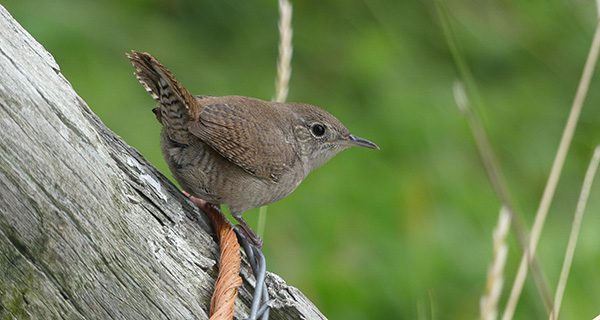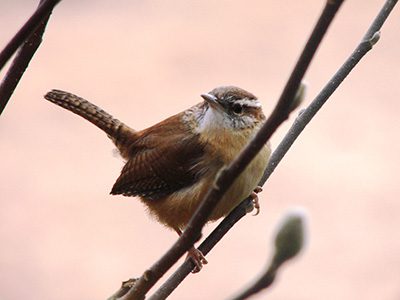By Stephen Press
Hometown Weekly Editor
A few months ago, before the cold precluded our doing so comfortably, I was sitting outside with an icy drink in my hand, enjoying the last of New England’s nice weather for the season.
As I sat, scanning my surroundings as I usually do, I heard some rustling in a nearby bush — so nearby as to startle me — followed by a series of differing, unfamiliar calls. I kept my eyes on the shrub, waiting for the reveal.
The individual making the noise, though, was not forthcoming. After a minute or two of fruitless staring, I grew self-conscious and looked away.
It was at this exact moment, of course, that the visitor chose to fly off, which I only caught in my peripheral vision.
It landed, however, in a gutter even closer to me than the plant in which it was previously hiding. I heard it begin to rummage around out of sight, not more than a few meters away from my head.
It was then that I decided to call out my visitor by name. “Well, wren,” I said in the most conversational tone I could muster, “you’re fooling nobody today. You ought to show yourself.”
The bird, without skipping a beat, leapt out from inside the gutter and onto the edge, making itself fully visible. It looked down at me as if to imply annoyance. “Well of course,” it seemed to suggest with its piercing stare, “who else would it have been?”
I couldn’t help but laugh. I had indeed been correct: this small brown bird with an upturned tail, slim bill and lighter belly was most certainly a house wren. I had guessed as much from its initial boldness, and from its abundant calls. What I hadn’t guessed is that this particular one would be so keen to express its exasperation at my interrupting its feeding.
With all due respect to my visitor, wrens aren’t much to look at. They are small — about the size of a sparrow or chickadee — and brown, with their defining feature being a short tail that often protrudes upwards at a seemingly awkward angle. They favor the sorts of hidden places and crevices, both on the ground and in trees or shrubs, where they’re able to find their primary food, insects. This would explain the drab coloring; it’s excellent camouflage, and seems to give them license to cavort about the forest with abandon. They are especially entertaining birds to watch. You’ll often find them in areas of transition between habitats — for example, where a forest meets a clearing (or where your yard meets the woods). With the house wren’s abundance being roughly the same as that of cardinals or mourning doves, all of Hometown Weekly’s communities support a sizable population. You can spot them anywhere, from a silent Sherborn lawn to the Walpole MBTA station at rush hour.
In terms of its pluck and willingness to get dirty, a wren will remind you of a chickadee. Both birds have acrobatic streaks, and can often be seen energetically exploring areas that might not seem accessible to other feeding birds. The difference is that the wren tends to be a bit more of a spelunker, exploring hollowed-out cavities and other dark places that might provide them either food or shelter. This would explain the name of its scientific family, Troglodytidae, literally “cave dweller.” Wrens also appear especially interested in human structures — which, combined with their preference for dark, insect-laden places, likely explains why my visitor was so keen to hang out in the gutter. I’ve also seen them surveying woodpiles, popping in and out of patio umbrellas, and even attempting to claim mailboxes as nesting sites (they’ll nest just about anywhere; I’ve seen photos of wren chicks incubating in old sneakers).
In the event that you hear a wren before you see one, you might find yourself a bit confused, as I was when I first heard my visitor in the bushes. While the house wren is a rather musical bird, it also has quite a wide repertoire, making identifying its specific songs a bit difficult. Average house wrens will cycle through around 25 different calls, though individuals west of the Mississippi have been known to employ as many as around 200. It seems song choice is environmentally mediated. A 2020 study in the International Journal of Avian Science suggests that in areas of abundant human noise pollution, house wrens will specifically select songs whose frequencies do not overlap or compete with the ambient soundscape. In this sense, the birds are true crooners, perpetually attentive to their audience’s reaction and not simply content to run through the greatest hits.
They are also rather single-minded, though. Soon after registering its annoyance with me, my late-autumn visitor ducked back into the gutter and began feeding again, its movements sending metallic echoes down the side of the roof as it explored. Our brief interaction had made the day for me. It’s not often that a momentary glance from a wild bird can precipitate the same laughter as an old friend shooting you a knowing, sarcastic look.
We often tend to lump all small, drab brown birds together into a general sparrow category — I myself am guilty of this offense. I suppose it makes them easier to write off as we encounter them, en masse, in our daily lives. What could such seemingly common, dull birds have to show us?
I implore you, though, to take the time to watch for a moment. That “sparrow” might in fact be a wren, and while it might not be the most striking bird in your backyard, what it lacks in good looks, it more than makes up for in character.
Personality, as they say, goes a long way.




















